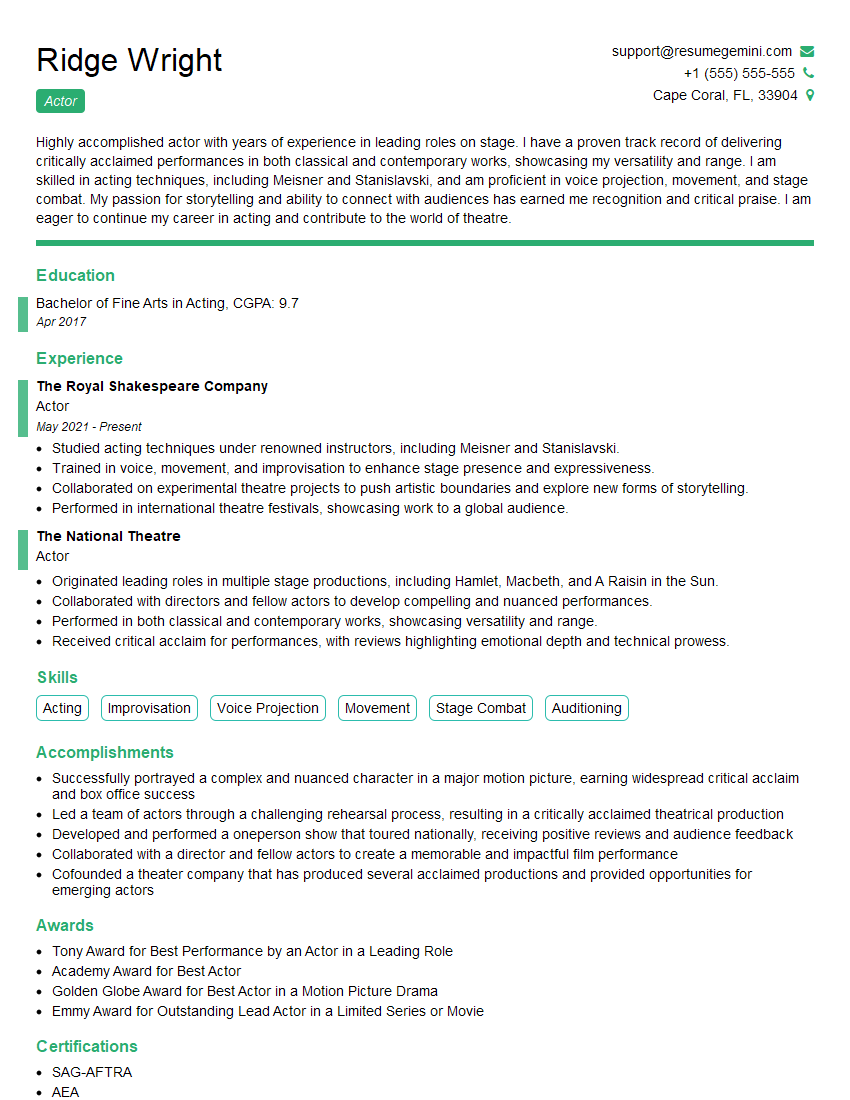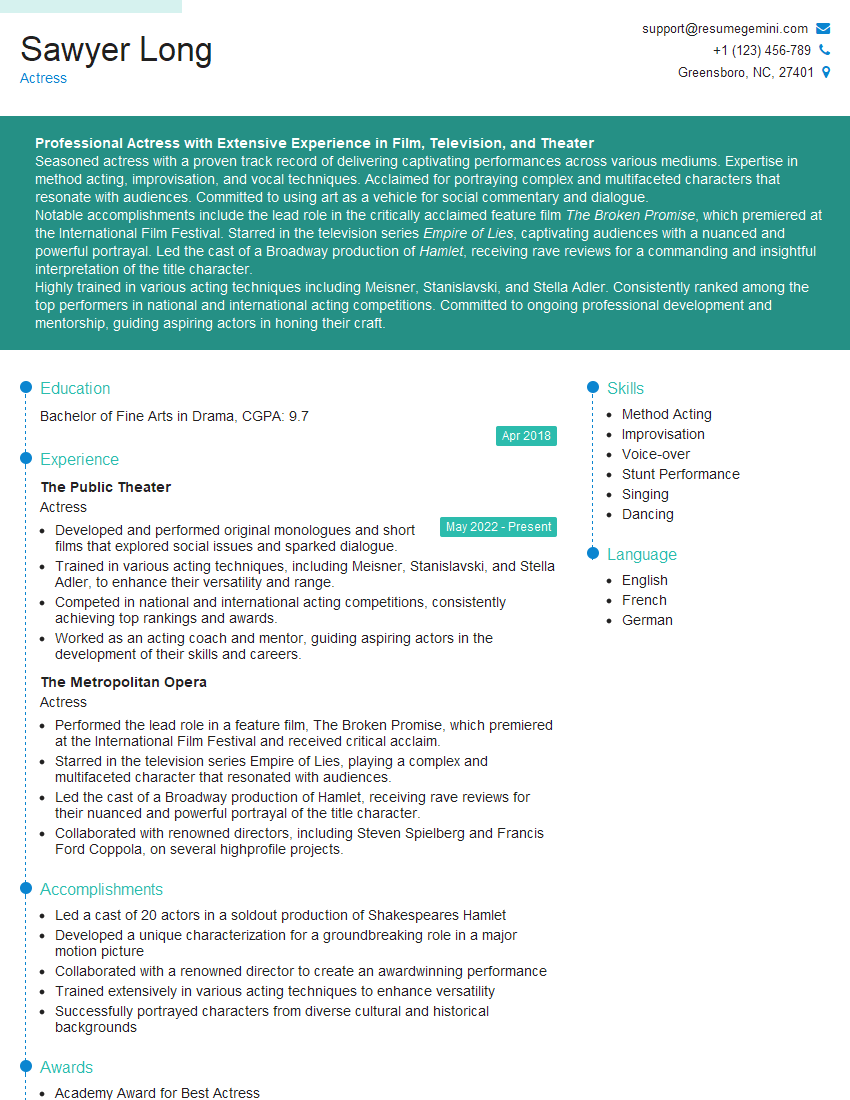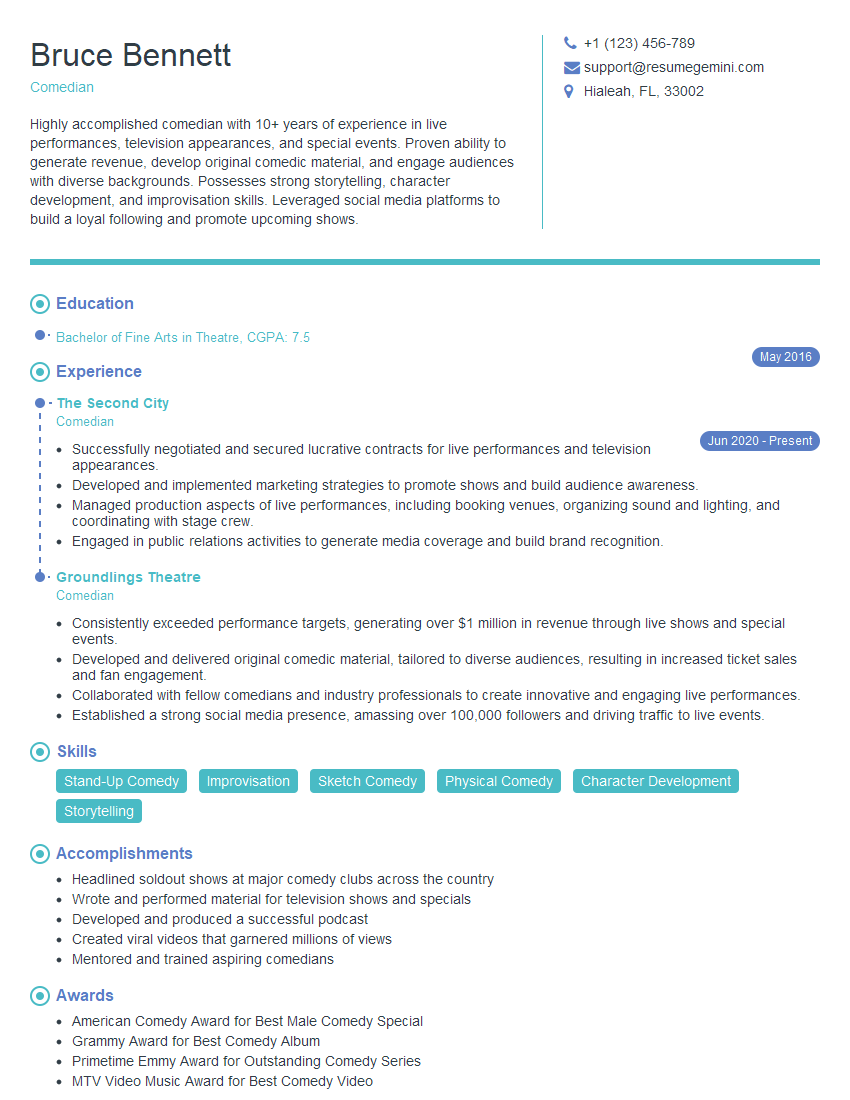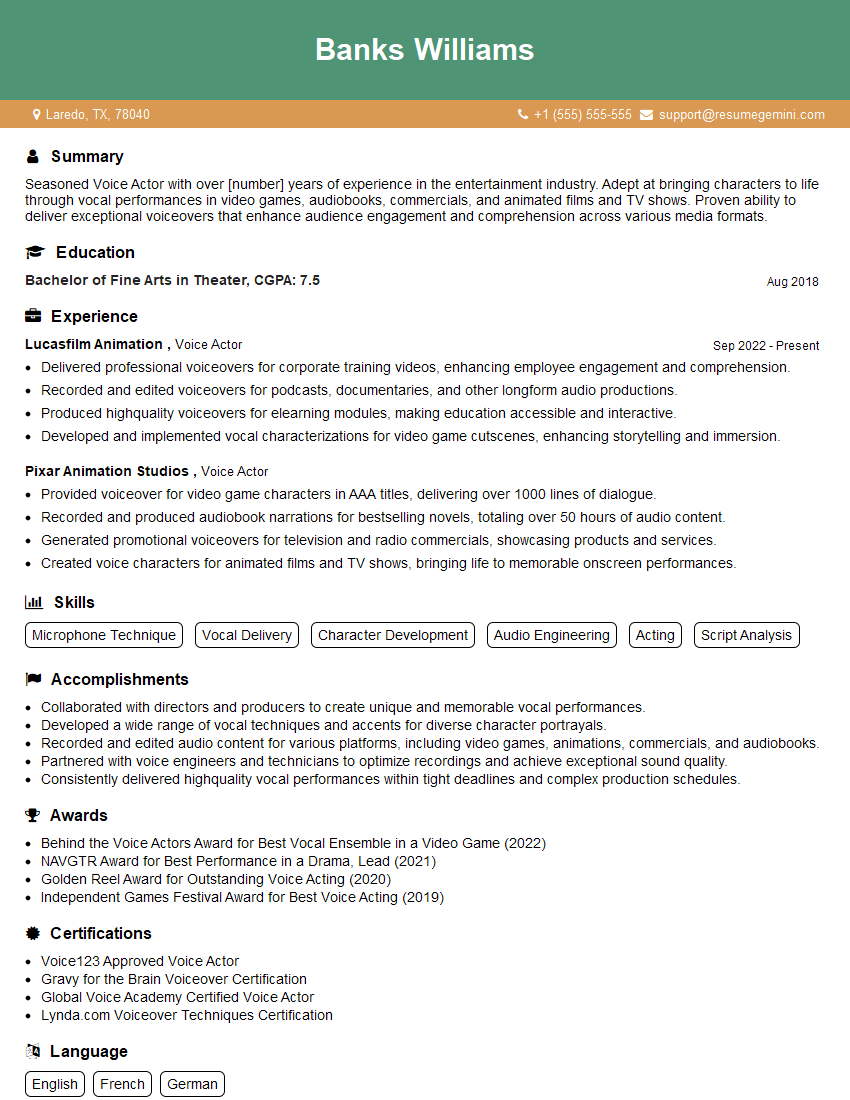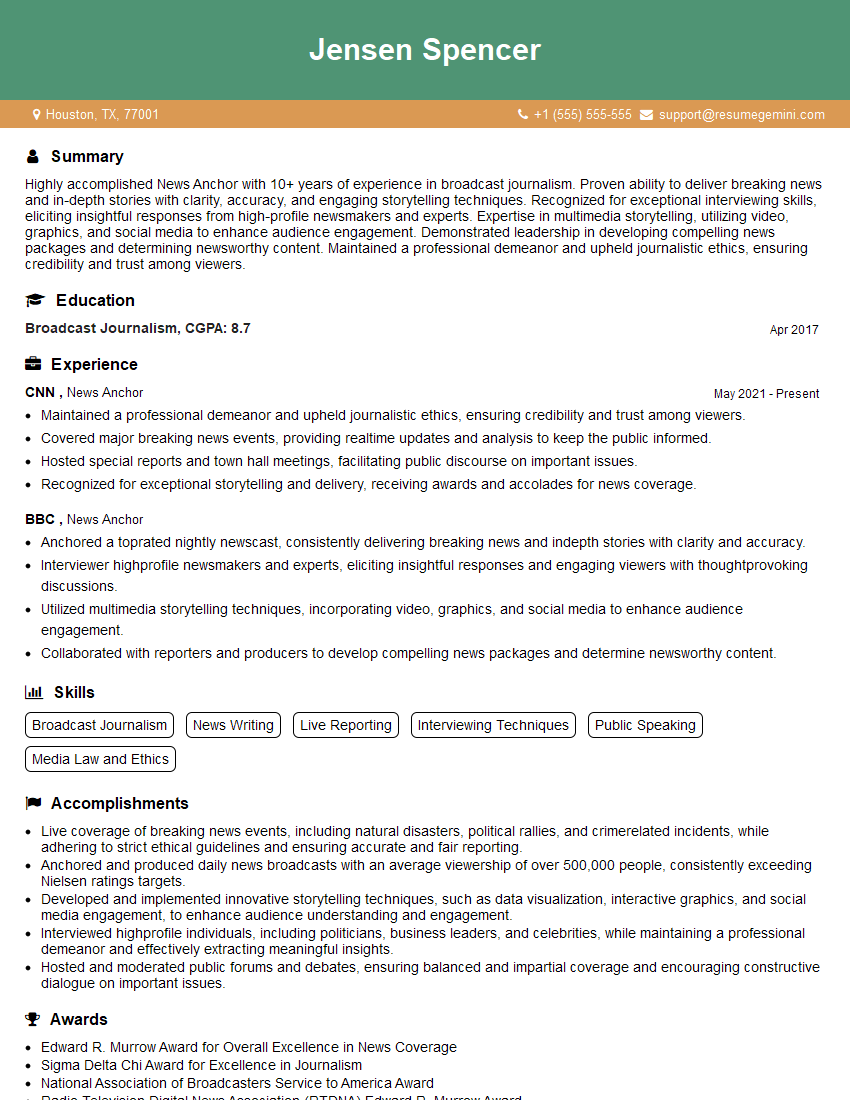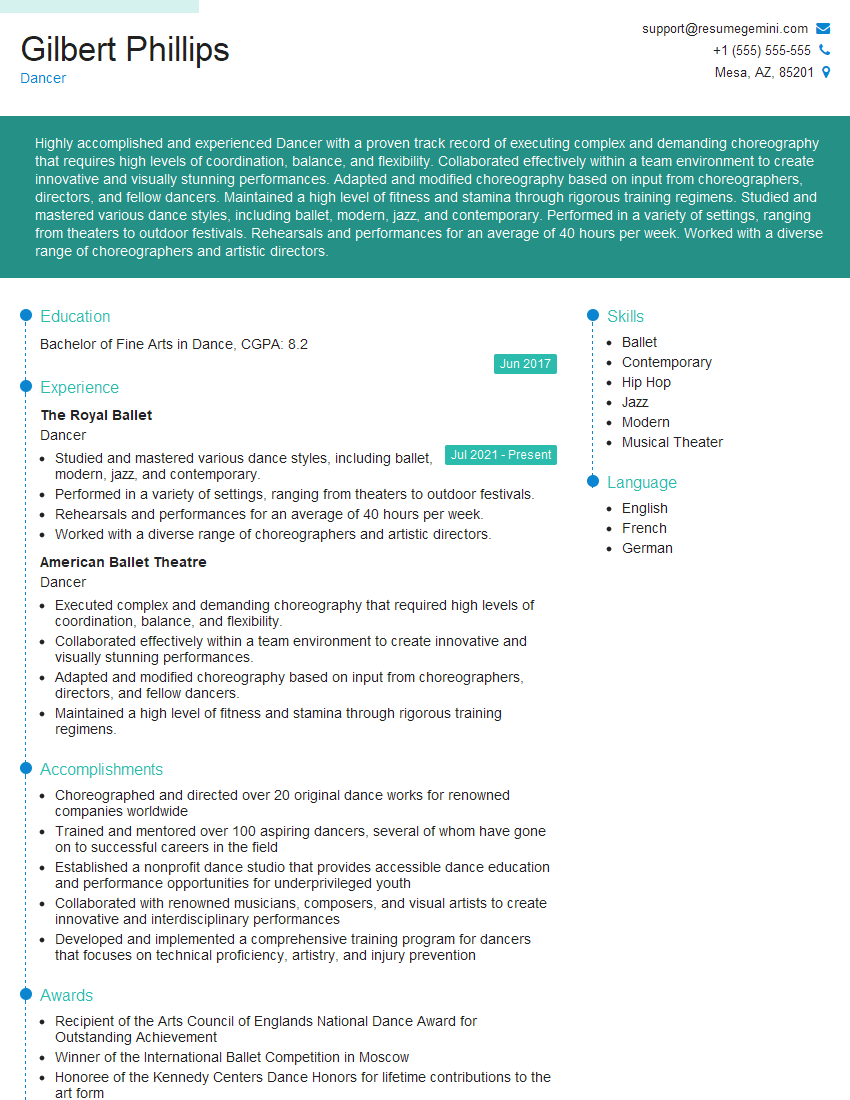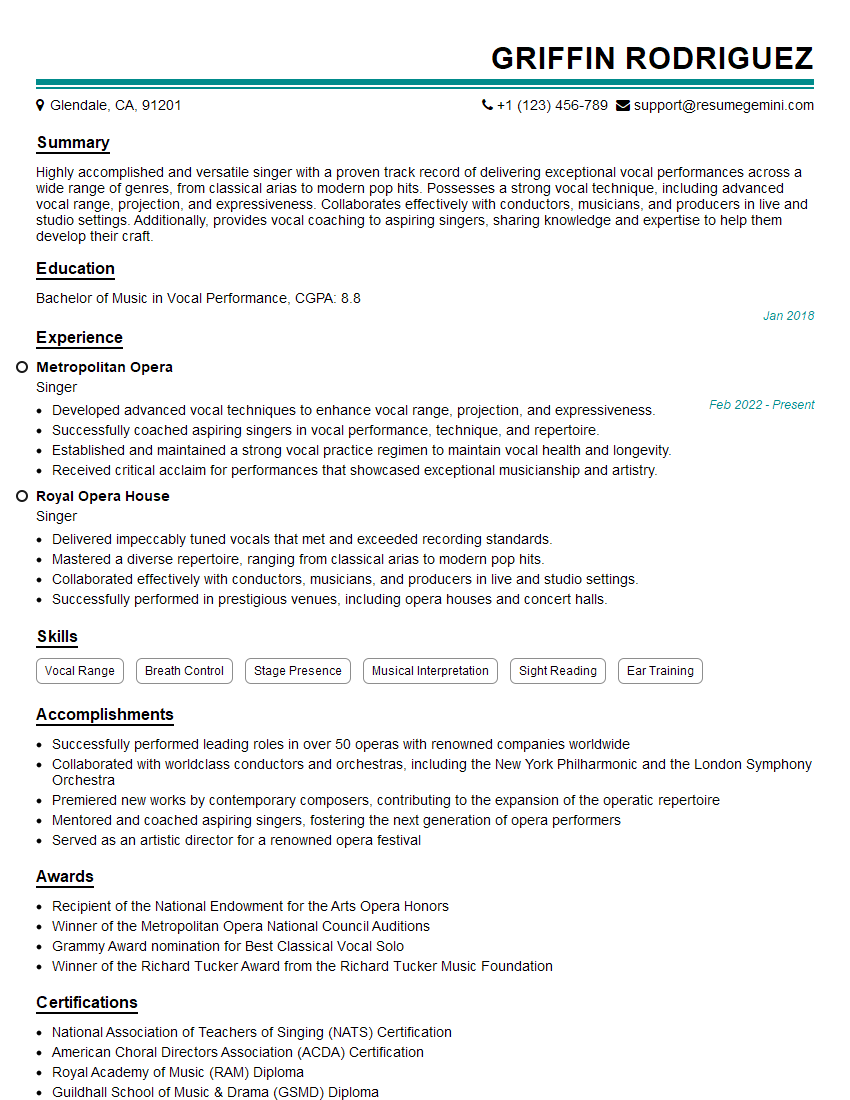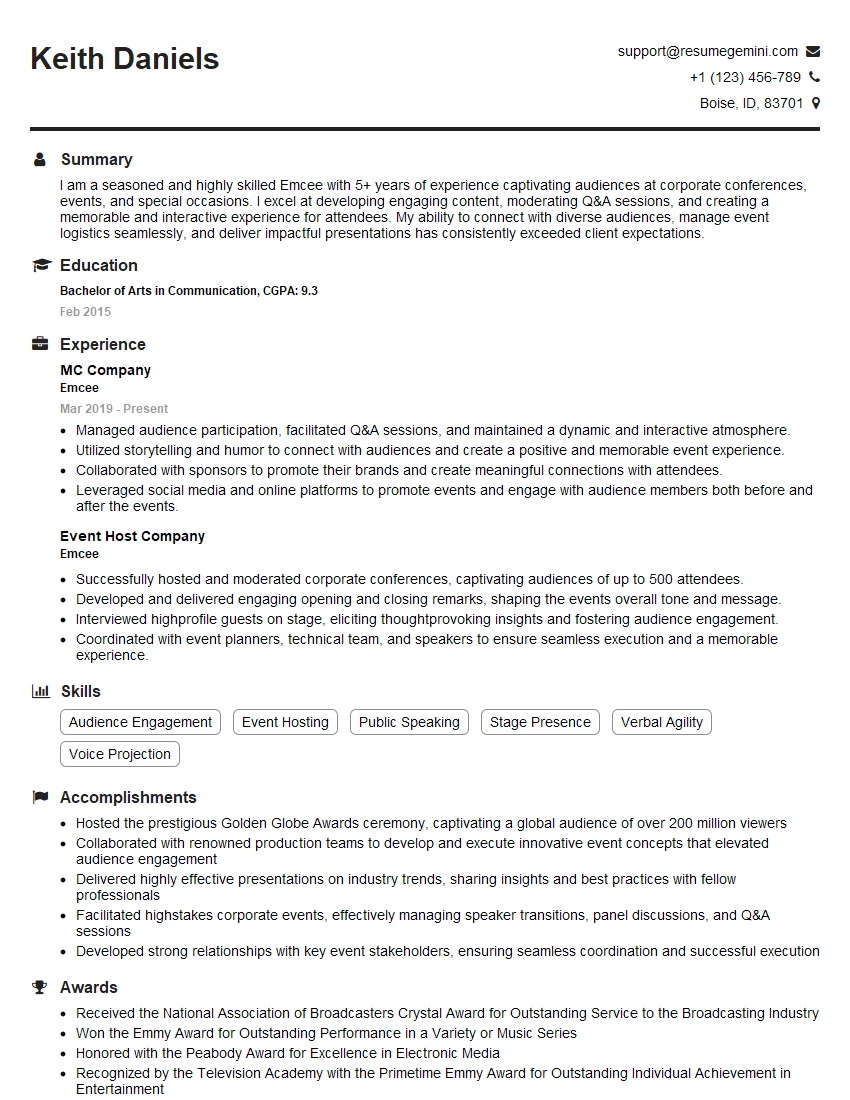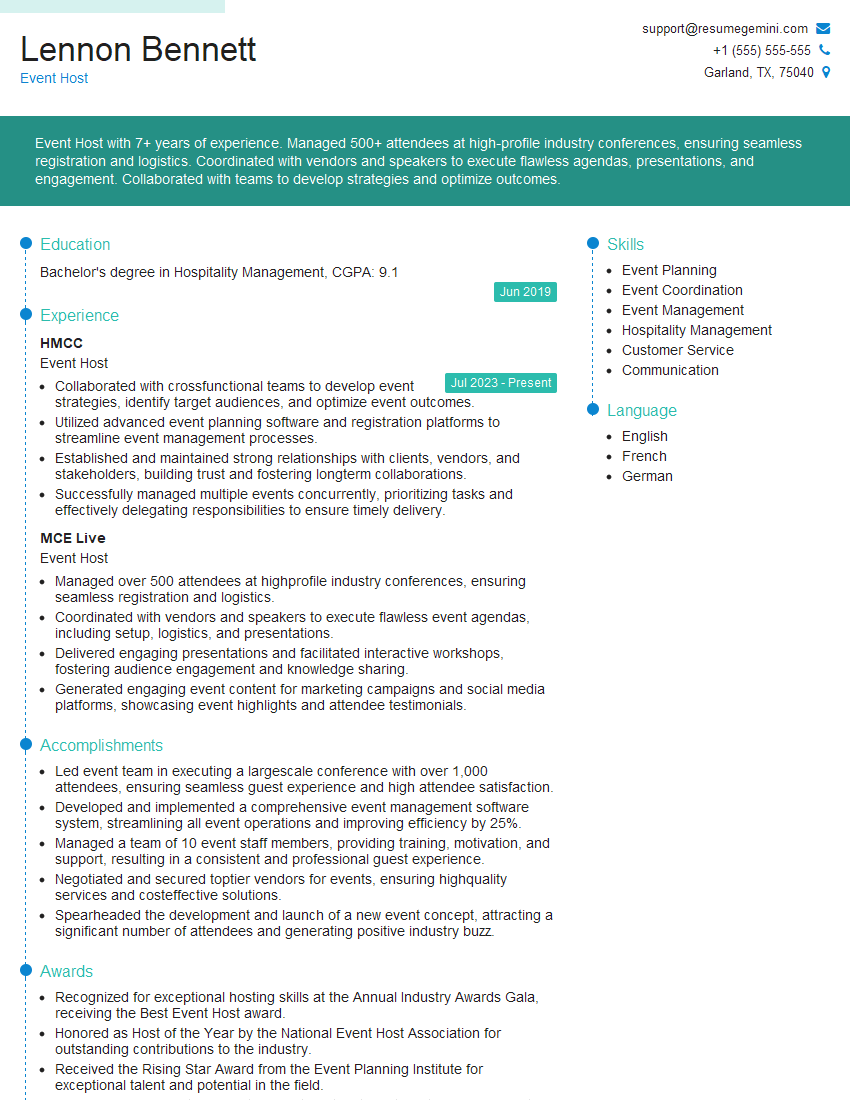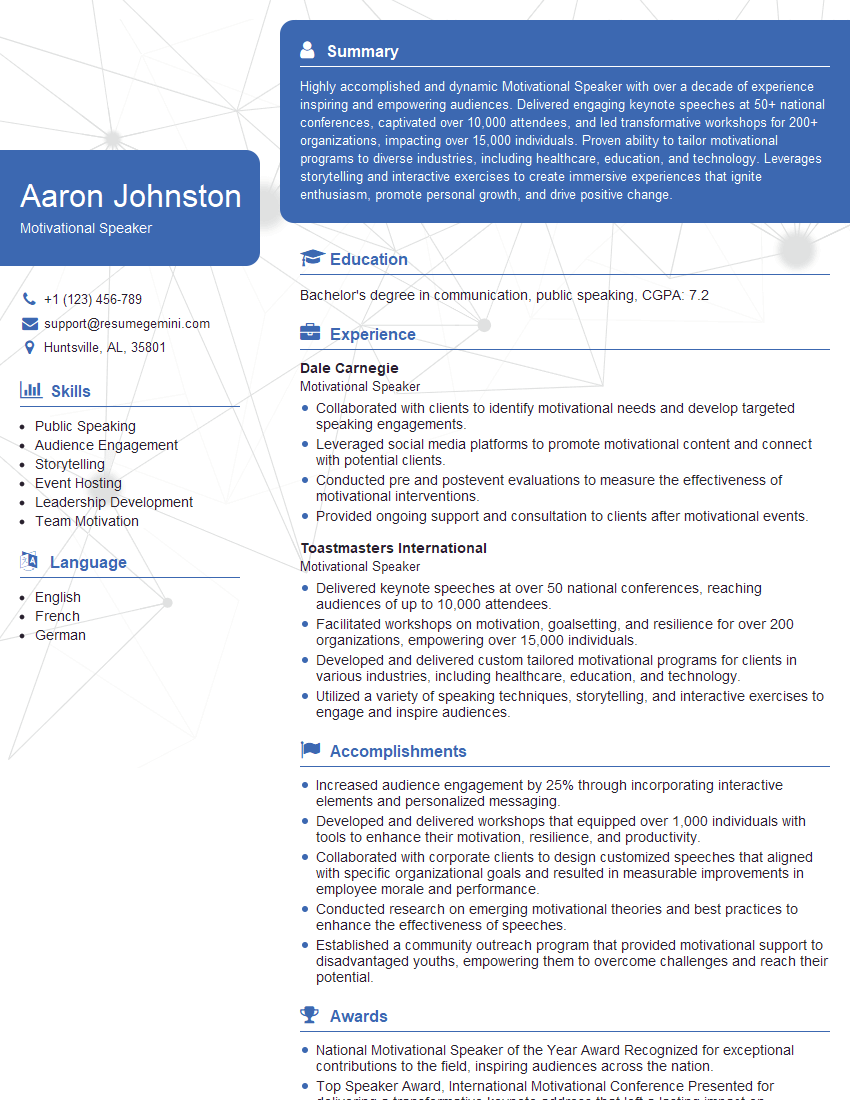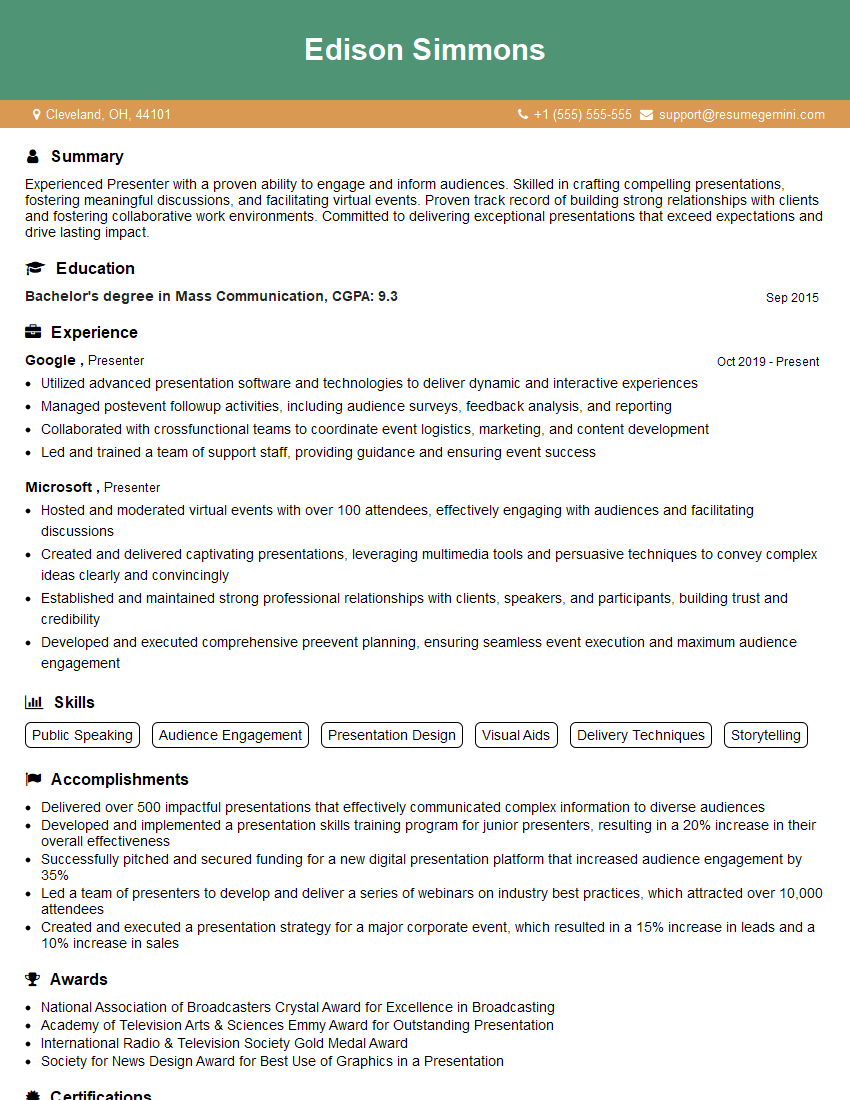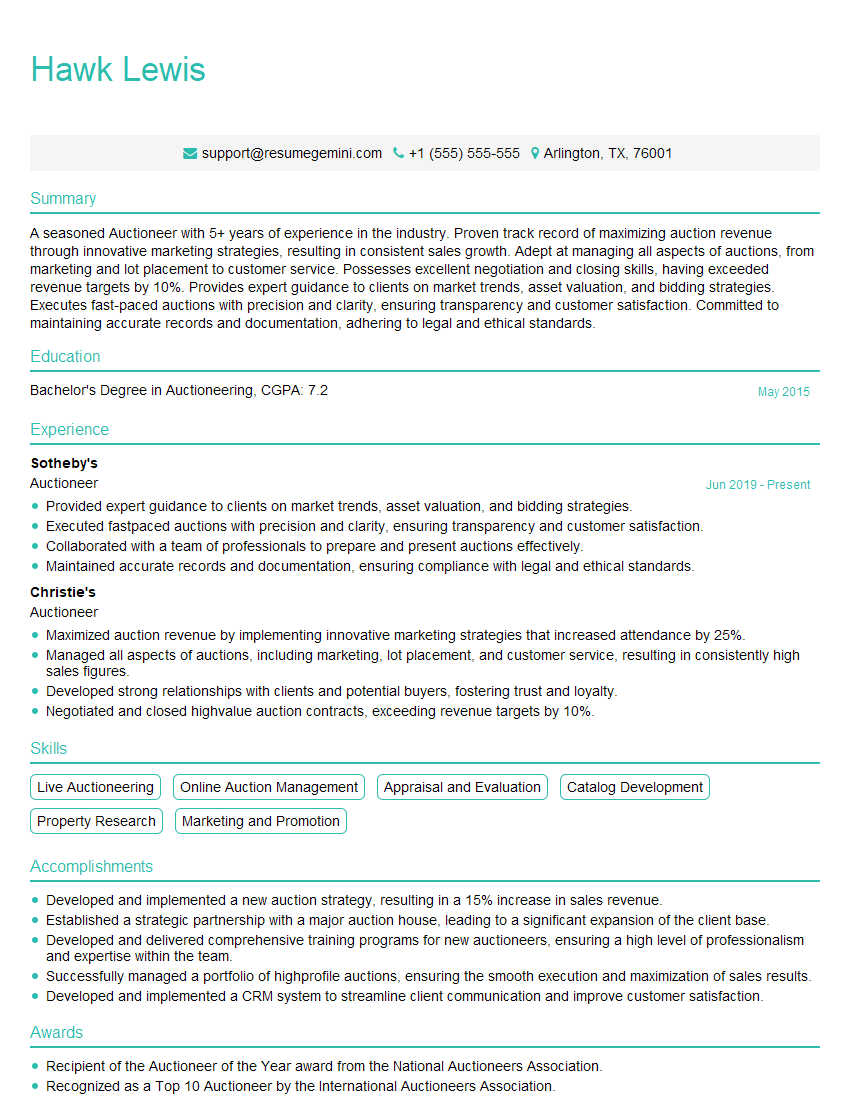The thought of an interview can be nerve-wracking, but the right preparation can make all the difference. Explore this comprehensive guide to Stage Presence and Performing Skills interview questions and gain the confidence you need to showcase your abilities and secure the role.
Questions Asked in Stage Presence and Performing Skills Interview
Q 1. Describe your approach to commanding attention on stage.
Commanding attention on stage isn’t about being loud or flashy; it’s about creating a connection with the audience. It starts with preparation – knowing your material inside and out so you can focus on delivery, not recall. My approach involves three key elements:
- Presence: This is about owning the space. I use controlled movement to occupy the stage effectively, making eye contact with different sections of the audience to create a sense of intimacy, even in a large venue. Think of it like radiating confidence, not aggressive posturing.
- Vocal Delivery: A clear, resonant voice is crucial. Varying tone, pace, and volume keeps the audience engaged, preventing monotony. Pauses are powerful tools – they give the audience time to process information and build anticipation.
- Emotional Connection: Authenticity is key. I strive to embody the emotions of the text, letting the message resonate within me and therefore to the audience. This genuine expression connects with people on a deeper level than a rote performance.
For example, in a recent corporate presentation, I began by pausing, making deliberate eye contact with individuals in the front row, before smoothly transitioning to a captivating anecdote that drew them in, setting the stage for the main presentation.
Q 2. How do you adapt your performance based on the audience?
Adapting to the audience is crucial for a successful performance. It’s about reading the room and adjusting my delivery to resonate with their energy and expectations. This involves observing:
- Their Energy Level: A high-energy audience might respond to a faster pace and more dynamic delivery, while a quieter audience might benefit from a more relaxed, conversational style.
- Their Reactions: I pay attention to body language – are they leaning in, are they engaged, or do I see signs of disinterest? If needed, I may adjust my pacing or storytelling approach to re-engage them.
- Their Background/Demography: If I know the audience beforehand, this influences my language and examples used. A younger crowd may respond better to modern references than an older audience.
For instance, I once presented a serious topic at a young professionals’ conference. I adapted my tone to be more relatable and energetic, integrating current event references and interactive elements to maintain their attention and engagement.
Q 3. Explain your process for memorizing lines or a speech.
Memorization is a multi-stage process for me. It’s not just rote learning; it’s about understanding and internalizing the text.
- Understanding: I begin by thoroughly reading the script, analyzing the character’s motivations, and the overall narrative arc. I might even create a character profile.
- Chunking: I break down the script into manageable chunks, focusing on understanding the meaning of each section before moving on.
- Active Recall: Instead of passively rereading, I actively test my recall – reciting sections aloud, writing them down from memory, or even recording myself.
- Rehearsal and Refinement: I rehearse in front of a mirror, or with a friend, focusing not only on the words but also on the emotional delivery and physicality of the character.
- Spaced Repetition: I review the material at increasing intervals to reinforce long-term retention.
For example, when learning Shakespearean sonnets, I focus deeply on understanding the language and imagery, then break it down line by line before piecing it together. Using visual aids or associating lines with specific emotions or imagery enhances memorization.
Q 4. How do you handle stage fright or unexpected interruptions?
Stage fright is a common experience, but manageable. My approach involves proactive preparation and coping mechanisms:
- Preparation: Thorough rehearsal is crucial. Knowing my material well builds confidence.
- Mindfulness and Breathing Exercises: I use deep breathing and mindfulness techniques to calm my nerves before a performance.
- Positive Self-Talk: Instead of focusing on potential failures, I focus on my strengths and past successes.
- Visualization: I visualize a successful performance, imagining the audience’s positive response.
- Handling Interruptions: If an unexpected interruption occurs, I pause, acknowledge it briefly (if appropriate), and smoothly transition back to my performance. Preparation allows me to remain flexible and adapt to unforeseen circumstances.
In one instance, a projector malfunctioned mid-presentation. By pausing, calmly addressing the issue (while the tech crew fixed it), and using that moment to briefly engage with the audience through anecdotes, I managed to maintain the audience’s attention and continue smoothly.
Q 5. Describe a time you had to improvise during a performance.
During a theatrical performance, a fellow actor forgot his lines. Instead of panicking, I subtly improvised, using the context of the scene to create a plausible cover. I ad-libbed a line that helped bridge the gap, giving him time to regain his composure and seamlessly re-enter the scene.
This required quick thinking and an understanding of the script’s overall narrative flow. I didn’t draw attention to the mistake; my goal was a smooth, natural transition that maintained the integrity of the performance. This moment taught me the value of adaptability and collaboration, ensuring a positive experience for the audience despite an unforeseen challenge.
Q 6. How do you project your voice effectively to a large audience?
Projecting your voice effectively requires more than just shouting. It’s about using your breath support and vocal technique:
- Breath Control: Proper breathing techniques, such as diaphragmatic breathing, provide the power and sustainment needed for clear projection.
- Posture: Standing tall with relaxed shoulders improves breath support and vocal resonance.
- Resonance: Using your chest and mouth cavities to amplify your voice is more impactful than just relying on force.
- Articulation: Clear enunciation ensures that the audience understands every word.
- Microphone Technique (If Applicable): Maintaining a consistent distance from the microphone and using proper vocal technique ensures clear sound without feedback.
Imagine your voice as a beam of light: you need to focus it, not just make it brighter. Practicing vocal exercises, particularly those that focus on breath control and resonance, strengthens these skills.
Q 7. Explain your understanding of nonverbal communication in performance.
Nonverbal communication is often more impactful than words. It’s the silent language of the body that enhances, or sometimes contradicts, what’s being said. In performance, this includes:
- Body Language: Posture, gestures, and movement convey emotion and character. A slumped posture might signal sadness or defeat, while a confident stance conveys authority.
- Facial Expressions: The face is the most expressive part of the body. Micro-expressions can add layers of meaning to a performance.
- Eye Contact: Connecting with the audience through eye contact creates intimacy and engages them emotionally.
- Proxemics: Use of space—how close or far you are from the audience or other performers—can change the dynamic of the scene.
- Kinesics: This involves the study of body movement, including gestures, posture, and facial expressions. Understanding kinesics allows for purposeful communication beyond words.
For example, a subtle shift in posture can indicate a character’s change in mood, while a lingering gaze can build tension or intimacy. Mastering nonverbal communication allows for a more nuanced and powerful performance, enabling the storyteller to connect with the audience on a deeper level.
Q 8. How do you maintain energy and enthusiasm throughout a long performance?
Maintaining energy and enthusiasm during a long performance is crucial for audience engagement. It’s a combination of physical and mental preparation. Think of it like pacing yourself in a marathon, not a sprint.
Physical Preparation: Proper hydration and nutrition before the performance are essential. I also incorporate regular exercise and stretching to maintain stamina and flexibility. During the performance, taking brief, strategic pauses allows for a moment to gather energy.
Mental Preparation: Visualizing a successful performance beforehand helps build confidence and positive energy. I also focus on connecting with the material, finding the parts I truly enjoy and using that as fuel. Remembering why I’m performing – to share my passion with the audience – helps keep the energy alive.
Audience Engagement: Actively engaging with the audience – making eye contact, responding to their reactions – creates a dynamic exchange that feeds the energy back and forth. This is far more energizing than simply performing at them.
For example, during a three-hour musical theatre performance, I might use the intermission to quickly hydrate, stretch, and refocus, mentally reviewing the second act to maintain momentum.
Q 9. How do you use your body language to enhance your message?
Body language is a powerful tool to amplify your message, going beyond just words. It’s about conveying authenticity and making a connection.
Posture: A confident, open posture – shoulders relaxed, head held high – shows assurance and professionalism. A slumped posture, conversely, can convey disinterest or insecurity.
Gestures: Use gestures purposefully. Avoid fidgeting or nervous movements; instead, use deliberate gestures to emphasize key points, illustrate ideas, or create emotional impact. Think of a conductor guiding an orchestra – their movements dictate the flow and feeling of the music.
Facial Expressions: Your face tells a story. Match your expressions to your message: a joyful expression for a happy moment, a serious one for a somber scene. A blank expression can quickly disengage your audience.
Movement: Consider how you use the stage. Purposeful movement adds dynamism and helps to highlight emotional shifts or transitions within the performance. Too much random pacing can be distracting.
For instance, when presenting a motivational speech, a broad, open gesture emphasizing a key phrase can significantly boost the impact of the message.
Q 10. Describe your experience with microphone technique.
Microphone technique is crucial for clear and consistent sound projection. It’s about more than just holding the mic; it’s about understanding its nuances.
Distance: Maintain a consistent distance from the microphone to avoid distortion or feedback. This distance may vary depending on the microphone type.
Angle: Angle the microphone correctly toward your mouth, aiming for optimal sound pickup. Experimenting with different angles can improve the quality of your vocal sound.
Movement: Avoid sudden movements that could cause jarring sounds or microphone noise. Practice smooth, controlled movements, especially if moving around the stage.
Vocal Technique: Even with a microphone, proper vocal projection, breathing, and articulation remain important. Don’t rely solely on the microphone to amplify a weak voice.
In a live music setting, I’ve had to adapt quickly to various microphone setups, understanding immediately if a microphone is dynamic or condenser to appropriately adjust my technique and positioning to get the best sound.
Q 11. How do you create an engaging connection with your audience?
Creating an engaging connection with the audience is about building rapport and making them feel seen and heard. It’s a two-way conversation, not a monologue.
Eye Contact: Making eye contact with individuals in different sections of the audience helps create a sense of intimacy and connection.
Storytelling: Incorporating personal anecdotes and relatable stories makes the content more human and engaging. People connect with genuine emotion and experience.
Interaction: Depending on the setting, try to incorporate interactive elements such as asking questions or inviting participation.
Authenticity: Be genuine and passionate about the material. Enthusiasm is contagious. Let your own passion shine through.
For example, during a presentation, pausing to make eye contact with someone who seems particularly engaged can create a spontaneous moment of connection, making them feel personally addressed.
Q 12. How do you manage your nerves before a performance?
Pre-performance nerves are normal; they show you care. The key is managing them, not eliminating them.
Preparation: Thorough rehearsal is crucial. The more familiar you are with the material, the more confident you’ll feel.
Relaxation Techniques: Practice deep breathing, meditation, or mindfulness exercises to calm your nervous system. Physical exercise can also help release tension.
Positive Self-Talk: Replace negative thoughts with positive affirmations. Focus on your strengths and past successes.
Visualization: Visualize a successful performance, imagining the positive energy and connection with the audience.
Before a big performance, I’ll often do a short guided meditation and focus on positive affirmations, reminding myself of my past successes and preparing my mindset for the show.
Q 13. How do you deal with critical feedback on your performance?
Dealing with critical feedback requires a professional and growth-oriented mindset. It’s an opportunity to learn and improve, not a personal attack.
Listen Objectively: Listen carefully to the feedback without getting defensive. Consider the source and their perspective.
Identify Areas for Improvement: Focus on specific constructive criticisms. What aspects of your performance need refinement?
Separate Feedback from Personal Feelings: Distinguish between objective observations and subjective opinions. Not all feedback is equally valid.
Implement Changes: Use the feedback to inform future performances. Experiment with different approaches and techniques.
For example, if I receive feedback that my gestures were distracting, I would analyze the performance video, paying attention to my movements. I would then practice more controlled and purposeful gestures during rehearsals.
Q 14. What strategies do you employ for vocal projection and articulation?
Vocal projection and articulation are essential for clear communication, particularly in larger venues or without amplification.
Breath Control: Proper breathing techniques are fundamental. Learning diaphragmatic breathing allows for greater control and power in your voice.
Resonance: Utilize your resonating chambers (chest, throat, head) to amplify your voice naturally.
Articulation: Pay attention to the clarity of each syllable and word. Practice tongue twisters and vocal exercises to improve articulation.
Vocal Warm-Ups: Always warm up your voice before a performance to prevent strain and fatigue. This includes gentle humming, scales, and tongue exercises.
I regularly incorporate vocal exercises into my daily routine, focusing particularly on improving clarity and breath support. This helps to maintain a healthy and powerful voice for longer performances.
Q 15. Explain your understanding of pacing and timing in a performance.
Pacing and timing are crucial for a captivating performance. Pacing refers to the speed and rhythm of the performance, while timing involves the precise placement of moments for maximum impact. Think of it like composing music; a perfectly paced performance flows smoothly, building tension and releasing it at the right moments. Poor pacing can lead to a monotonous or rushed experience.
For example, a dramatic monologue might start slowly, building intensity as the character reveals their emotions. A comedic skit, on the other hand, often relies on rapid-fire dialogue and precisely timed physical comedy for maximum laughs. Mastering pacing requires careful consideration of the narrative arc, character development, and the overall emotional journey the audience should experience. It’s about knowing when to hold back, when to accelerate, and when to pause for breath – both literally and figuratively.
Timing is often about the precise delivery of a punchline, a significant revelation, or a powerful gesture. A well-timed pause can be more impactful than any words. I always practice meticulously, experimenting with different speeds and pauses to find what resonates best with the material and my audience.
Career Expert Tips:
- Ace those interviews! Prepare effectively by reviewing the Top 50 Most Common Interview Questions on ResumeGemini.
- Navigate your job search with confidence! Explore a wide range of Career Tips on ResumeGemini. Learn about common challenges and recommendations to overcome them.
- Craft the perfect resume! Master the Art of Resume Writing with ResumeGemini’s guide. Showcase your unique qualifications and achievements effectively.
- Don’t miss out on holiday savings! Build your dream resume with ResumeGemini’s ATS optimized templates.
Q 16. Describe your approach to using stage lighting and special effects.
My approach to lighting and special effects is deeply collaborative. I work closely with the lighting designer and technical director to ensure the effects enhance the story and emotional arc, not distract from it. It’s about creating a mood, highlighting key moments, and guiding the audience’s eye.
For instance, in a scene depicting a character’s growing despair, we might use gradually dimming lights and a shift to cooler tones. Conversely, a celebratory scene might feature brighter, warmer lights and perhaps even some strobe effects to emphasize the energy. I always make sure the effects serve the narrative, supporting the actors and not overpowering them. We’ll often rehearse with the lighting cues to ensure everything is synchronized and effective.
The use of special effects should be carefully considered. Too many effects can be overwhelming, while a well-placed effect can profoundly impact a scene. I prefer subtlety and precision, using effects to underscore the emotion and atmosphere created by the performance, not replace it.
Q 17. How do you handle technical difficulties during a performance?
Technical difficulties are inevitable, so preparedness is key. My approach is threefold: proactive prevention, quick thinking, and audience engagement. Before each performance, I conduct thorough technical checks and have a backup plan for potential issues, such as a malfunctioning microphone or lighting glitch. This includes having alternative lines prepared or adaptable movements.
During a performance, if a problem arises, I prioritize maintaining the flow and connection with the audience. If my microphone cuts out, I might project my voice more, or if a prop malfunctions, I’ll improvise a solution, maybe even playfully incorporating the mishap into the performance. The key is to handle the situation calmly and professionally, turning a potential disaster into an unexpected moment of connection.
By acknowledging the issue with humor and grace, I can often diffuse any tension and prevent it from ruining the overall experience. The audience appreciates genuine adaptability and professionalism.
Q 18. How do you incorporate audience participation effectively?
Effective audience participation enhances the energy and creates a shared experience. My approach depends on the type of performance. For interactive theatre, I carefully plan moments for audience engagement, ensuring it’s natural and relevant to the story. This could involve simple questions, incorporating audience suggestions, or even having them participate in a scene.
In a more traditional setting, I may incorporate audience reaction into my performance, reacting to their laughter or gasps in a way that builds the story and adds spontaneity. The crucial aspect is that any audience participation must be seamless and appropriate for the tone and style of the performance. It’s vital to create a safe and comfortable environment for participation, ensuring everyone feels included and respected.
I always aim for a balance, never forcing participation but allowing opportunities for audience connection. The goal is to foster a sense of shared experience, making the performance more memorable and engaging for everyone involved.
Q 19. Describe your experience with different performance venues and their unique challenges.
I’ve performed in a variety of venues, from intimate black-box theaters to large-scale outdoor amphitheaters. Each venue presents unique challenges. In smaller venues, the connection with the audience is more immediate, demanding nuanced acting, but sound projection and amplification are less critical.
Larger venues require adjustments to projection, pacing, and physicality to reach the farthest audience member. Outdoor venues present further complexities, such as weather conditions and unpredictable ambient noise. My approach involves careful pre-performance site visits, adapting my performance to the specific acoustics and visual requirements of the venue. I always prioritize clear communication with the technical crew to ensure a smooth and successful performance, regardless of the space.
Adaptability is crucial. I am comfortable working with limited resources in a small venue, and just as comfortable projecting my voice and energy into a stadium.
Q 20. What is your preferred method for rehearsing a performance?
My preferred rehearsal method is a blend of structured and improvisational approaches. I start with thorough script analysis, understanding character motivations and relationships. This is followed by structured rehearsals focusing on blocking, line delivery, and character development. This involves multiple read-throughs, focusing on pace and clarity, then working on characterization and staging.
Once a solid foundation is established, I incorporate improvisation to explore alternative interpretations, develop spontaneity, and enhance character depth. This helps actors to feel more comfortable and confident with their roles. I also believe in incorporating feedback sessions, both from the director and fellow actors, to refine the performance. This collaborative process ensures that the final product is polished and engaging.
The process is iterative, continuously refining and improving based on feedback and observation. I believe the best rehearsals are collaborative, focusing on mutual support and refinement.
Q 21. How do you utilize costume and props to enhance your performance?
Costumes and props are more than just accessories; they are integral tools for storytelling. I work closely with the costume and prop designers to ensure that these elements support the character’s personality, social standing, and the overall thematic message of the performance. The costume should reflect the character’s inner world and the story being told.
For example, a tattered coat might suggest poverty and hardship, whereas a flamboyant outfit could indicate confidence and extravagance. Props similarly contribute to the narrative, acting as visual cues and aids to the actors. A specific item, like a worn photograph, can evoke powerful emotions and memories in the character, adding layers of meaning.
My goal is to ensure that every detail, from the costume to the smallest prop, aligns with the overall message, contributing meaningfully to the performance and leaving a lasting impression on the audience. I also practice using props to ensure smooth and seamless handling.
Q 22. Explain your understanding of character development for acting roles.
Character development is the cornerstone of believable acting. It’s the process of building a fully realized individual from the script’s bare bones, imbuing them with a unique history, motivations, and emotional landscape. This goes far beyond simply memorizing lines; it’s about inhabiting the character’s skin.
I approach character development through a multi-faceted process. First, I carefully analyze the script, identifying the character’s relationships, goals, and conflicts. Then, I delve into backstory: What’s their past? What shaped their beliefs and behaviors? I create a detailed backstory, even if it’s not explicitly shown in the script – this informs their present actions. Next, I explore their physicality – their posture, gait, voice, and even their mannerisms. Finally, I explore their emotional arc: How do they change throughout the story? What are their internal struggles?
For example, in a recent role as a hardened detective, I didn’t just focus on the tough exterior. I created a backstory of a childhood trauma that fueled their cynicism, yet also imbued them with a deep, hidden empathy. This backstory informed subtle choices in their performance, making their actions believable and resonant with the audience.
Q 23. How do you prepare for an interview involving a live performance element?
Preparing for an interview with a live performance element requires meticulous planning and rehearsal. I start by analyzing the requirements: What is the expected performance? What are the technical aspects – props, lighting, sound? What kind of audience am I addressing? I tailor my preparation to these specific needs.
I would then craft a concise, engaging performance that directly addresses the interview’s objectives. This involves selecting relevant material and honing the delivery. I rehearse extensively, paying attention to pacing, clarity, and body language. Crucially, I also practice handling potential technical difficulties or unexpected questions during the performance, ensuring I can maintain composure and professionalism even under pressure.
Finally, I conduct a thorough technical run-through in the actual performance space, if possible, to familiarize myself with the environment and ensure smooth execution. This allows me to anticipate and address any potential issues before the actual interview.
Q 24. Describe a situation where you had to quickly adjust to a change in performance circumstances.
During a student production of ‘Hamlet’, the actor playing Claudius fell ill just before the curtain. I was playing Horatio, and despite my limited lines, I had to step in, learning Claudius’s crucial final scene lines in under an hour. This demanded quick thinking and adaptability.
My approach was threefold: I focused on the emotional core of the scene, understanding the character’s motivations. Then, I prioritized the key plot points, ensuring I hit the most important beats, even if the nuances were lost. Finally, I used my understanding of the play’s overall narrative to guide my improvisation within the existing structure. It wasn’t perfect, but it ensured the show went on and maintained audience engagement.
This experience reinforced the importance of being prepared for unforeseen circumstances and having a flexible approach to performance. It also showcased my ability to work under pressure and use my skills resourcefully in a crisis.
Q 25. How do you maintain professionalism and composure under pressure?
Maintaining professionalism and composure under pressure comes from a combination of preparation, mental discipline, and self-awareness. Thorough rehearsal reduces anxiety, allowing me to focus on the performance rather than worrying about forgetting lines or messing up technically.
Mentally, I employ techniques such as deep breathing and visualization to center myself. I remind myself that mistakes happen and they’re opportunities for growth. It’s important to acknowledge nervousness, but not let it control me. Maintaining eye contact with the audience and focusing on the task at hand helps to ground me.
Self-awareness allows me to recognize my own triggers and develop strategies to manage them. For example, if I notice I tend to clam up under intense scrutiny, I’ll actively practice engaging with challenging questions during rehearsals. This prepares me for handling difficult situations gracefully and professionally.
Q 26. How do you handle constructive criticism from directors or colleagues?
I view constructive criticism as an invaluable tool for growth. I approach it with an open mind, actively listening and seeking clarification if needed. I avoid becoming defensive; instead, I aim to understand the director’s or colleague’s perspective and identify areas for improvement.
My process involves first acknowledging the feedback, then analyzing its validity. Is it accurate? Does it align with my own self-assessment? If it’s valid, I carefully consider how to incorporate the suggestions. If I’m unsure, I’ll ask clarifying questions to gain a deeper understanding. This collaborative approach fosters a productive environment and ensures continuous development.
For instance, if a director comments on a lack of emotional depth in a scene, I’ll reflect on my portrayal, researching the character’s backstory further, and experimenting with different techniques to convey the intended emotions more effectively. This continuous process of self-reflection and refinement is vital for growth as a performer.
Q 27. What are your strengths and weaknesses regarding stage presence?
My strengths in stage presence include confident vocal delivery, strong physicality, and a capacity for emotional connection with the audience. I’m comfortable commanding attention and captivating an audience through varied techniques, from storytelling to physical comedy.
However, a weakness I am actively working on is adjusting my performance for different sized venues. While I excel in intimate settings, adapting my energy and projection for larger spaces requires conscious effort and practice. I am addressing this by deliberately seeking performance opportunities in varied venues and seeking feedback from directors on how effectively I’m filling the space.
Q 28. How do you maintain audience engagement throughout a presentation?
Maintaining audience engagement during a presentation hinges on effective communication and captivating storytelling. I begin by establishing a strong connection with the audience early on, engaging them with a compelling opening and maintaining eye contact. Varying my vocal tone, pace, and body language keeps the presentation dynamic and prevents monotony.
Incorporating visual aids, anecdotes, and interactive elements further enhances engagement. Visuals should be relevant and enhance understanding, not distract. Anecdotes and stories make the information relatable and memorable. Interactive elements, like polls or Q&A sessions, directly involve the audience.
For instance, I might start with a relevant anecdote to grab attention, then use visuals to illustrate key points, and finally, conclude with a call to action to leave the audience with a lasting impression. It’s a balance of informative delivery and engaging performance, creating a memorable experience for the viewers.
Key Topics to Learn for Stage Presence and Performing Skills Interview
- Commanding Presence: Understanding and projecting confidence, authority, and charisma. Practical application: Analyze your body language on video recordings and identify areas for improvement in posture, gestures, and eye contact.
- Vocal Delivery: Mastering articulation, projection, pace, and tone to effectively communicate your message. Practical application: Practice delivering a short presentation, recording yourself and analyzing your vocal clarity and inflection.
- Storytelling & Engagement: Crafting compelling narratives and engaging your audience through impactful storytelling techniques. Practical application: Develop concise, memorable anecdotes showcasing your skills and experiences.
- Handling Nervousness: Developing coping mechanisms for managing anxiety and maintaining composure under pressure. Practical application: Practice mindfulness techniques or relaxation exercises before presentations or interviews.
- Audience Connection: Building rapport and establishing a genuine connection with the interviewer or audience. Practical application: Practice active listening and responding thoughtfully to questions and prompts.
- Nonverbal Communication: Understanding the impact of body language, facial expressions, and gestures on communication. Practical application: Observe experienced presenters and analyze their nonverbal communication techniques.
- Adaptability & Improvisation: Responding effectively to unexpected questions or situations with grace and professionalism. Practical application: Practice impromptu speaking exercises to build confidence and quick thinking.
Next Steps
Mastering Stage Presence and Performing Skills is crucial for career advancement across numerous fields. These skills are highly valued by employers, demonstrating your ability to communicate effectively, build relationships, and lead with confidence. To maximize your job prospects, create an ATS-friendly resume that highlights your achievements and showcases these key abilities. ResumeGemini is a trusted resource to help you build a professional and impactful resume that grabs attention. Examples of resumes tailored to Stage Presence and Performing Skills are available to provide further guidance. Take the next step towards a successful career by crafting a resume that reflects your exceptional talent.
Explore more articles
Users Rating of Our Blogs
Share Your Experience
We value your feedback! Please rate our content and share your thoughts (optional).
What Readers Say About Our Blog
Hello,
We found issues with your domain’s email setup that may be sending your messages to spam or blocking them completely. InboxShield Mini shows you how to fix it in minutes — no tech skills required.
Scan your domain now for details: https://inboxshield-mini.com/
— Adam @ InboxShield Mini
Reply STOP to unsubscribe
Hi, are you owner of interviewgemini.com? What if I told you I could help you find extra time in your schedule, reconnect with leads you didn’t even realize you missed, and bring in more “I want to work with you” conversations, without increasing your ad spend or hiring a full-time employee?
All with a flexible, budget-friendly service that could easily pay for itself. Sounds good?
Would it be nice to jump on a quick 10-minute call so I can show you exactly how we make this work?
Best,
Hapei
Marketing Director
Hey, I know you’re the owner of interviewgemini.com. I’ll be quick.
Fundraising for your business is tough and time-consuming. We make it easier by guaranteeing two private investor meetings each month, for six months. No demos, no pitch events – just direct introductions to active investors matched to your startup.
If youR17;re raising, this could help you build real momentum. Want me to send more info?
Hi, I represent an SEO company that specialises in getting you AI citations and higher rankings on Google. I’d like to offer you a 100% free SEO audit for your website. Would you be interested?
Hi, I represent an SEO company that specialises in getting you AI citations and higher rankings on Google. I’d like to offer you a 100% free SEO audit for your website. Would you be interested?
good




